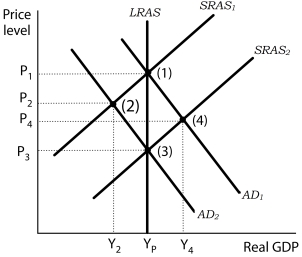Multiple Choice
Figure 17-2 
-Refer to Figure 17-2. The economy is initially in equilibrium at point (1) . Now suppose a reduction in the money supply causes aggregate demand to fall to AD2. Which of the following explains the new classical view regarding economic agents' response to the decrease in money supply?
A) Consumers and firms observe that the money supply has fallen and that the price level has fallen to P2. Consumers respond by increasing their demand for output and firms in turn increase their supply to meet the rising demand. The economy moves back to point (1) .
B) Consumers and firms observe that the money supply has fallen and that the price level has fallen to P2. To prevent further reductions in the price level, firms increase output at the same time as consumers increase aggregate demand. The economy moves to point (4) , bypassing point (3) .
C) Consumers and firms observe that the money supply has fallen and anticipate the eventual reduction in the price level to P3. They adjust their expectations accordingly. Workers agree to lower nominal wages, and the short-run aggregate supply curve shifts to SRAS2 at the same time as aggregate demand falls, bypassing point (2) .
D) Consumers and firms observe that the money supply has fallen and anticipate the eventual reduction in the price level to P4. They adjust their expectations accordingly. Workers agree to lower nominal wages, and the short-run aggregate supply curve shifts to SRAS2 at the same time as aggregate demand rises, moving the economy to point (4) .
Correct Answer:

Verified
Correct Answer:
Verified
Q7: When consumers and producers operate under rational
Q14: New classical theory asserts that, because people
Q17: Keynesian economics was mostly concerned with the
Q63: Monetarists argue that<br>A) the Federal Reserve System
Q79: The economic theory based on an analysis
Q112: Figure 17-3 <img src="https://d2lvgg3v3hfg70.cloudfront.net/TB5507/.jpg" alt="Figure 17-3
Q114: Figure 17-1 <img src="https://d2lvgg3v3hfg70.cloudfront.net/TB5507/.jpg" alt="Figure 17-1
Q115: Which of the following is true about
Q118: Suppose the economy experiences a recessionary gap.
Q122: The events of the 1980s and early